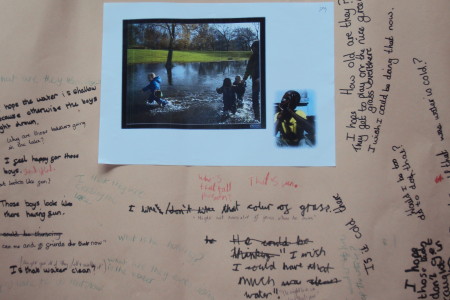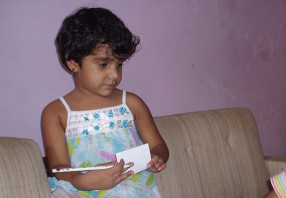Ours is a church school in a fairly affluent area in Southern England. Pupils have a generally stereotypical view of the world, unintentionally reinforced by charity appeals, some curriculum studies, and news broadcasts. For example pupils completed the What would you see in a country in Africa? activity and there was a high incidence of stereotypical or negative answers. It was felt they would benefit from a series of activities to broaden their horizons.
We decided to focus on empathy, choosing activities that would challenge ideas and preconceptions. The work was mainly carried out with Years 2, 3 and 4 (age 6 to 9). There were four pictures: a white child watching black children playing, a white child watching white children playing, a black child watching black children playing and a black child watching white children playing. Each group noted thoughts or questions arising from their picture, then looked at the same scene through the eyes of the other watcher, commenting on the previous group’s work and adding their own. There was then a general discussion with the teacher asking focussed questions based on the work.
| Picture | Responses | Comments |
| Black child / black children playing | Both referenced fun, cold, lack of adult supervision, wanting to join in | I hope their mum and dad are with them
That looks like fun, If I was there I would be happy to be there It’s cold They look happy |
| White child / black children playing | Can I go there?
Why are they on their own? It looks cold Are they dancing? They look like they are having a great time |
|
| Black child/ white children playing | A few references to green grass, amount of water, and likelihood of disease or danger, wanting to join in | Can me and my friends do that now?
Is that water clean (might they get ill if they fall and swallow it?) I wonder if the water is cold I like that colour of grass (he might not have grass where he lives) I want to join in the fun I hope the water is shallow because otherwise the boys might drown. |
| White child/ white children playing | Likelihood of flooding, fun, wanting to join in | I love swimming
I want to play in the water Has there been a flood? How deep is the water? I want to go and join in |
We classified the responses for each picture into three categories based on the nature of the comments: empathy, concern and stereotype. The audit showed that some of the children made a definite distinction between the black and the white child when viewing the pictures. They assumed that the black child would not be familiar with green grass, his access to water might be limited and he might think that water posed hidden dangers, whereas they assumed the white child thought more of the fun aspect, but thought both had a desire to join in.
In response to these findings we carried out several intervention tasks. We instituted Tuesday Newsday, where pupils saw items of world news, discussed them and pinpointed relevant locations on a map. We used this activity to facilitate philosophical enquiry.
Pupils also saw and discussed pictures of locations that you could find in most countries (cities, slums, shops, open areas). Children who participated in these activities showed an increased awareness of what was around them, asked more probing questions and stopped accepting things as ‘fact’ without questioning the sources of information. It was found that the Philosophy for Children methodology enabled more critical thinking, more respect for the views of others, and a deeper understanding of how others think and feel.
Second audit
The activity was repeated after several months and the interventions mentioned. We observed a decrease in the number of responses, from 153 to 121. The lower number of responses in the repeat activity could be due to a more considered approach by the children, with the replies being less obvious and more thoughtful.
The results show an increase in empathy, especially when looking at a white child watching white children, and with a much lower increase when watching the black children. The empathy shown for the black child showed a more balanced percentage increase; could this be because activities have been skewed towards an increased awareness of the feelings of ethnicities other than the children’s own? This might also explain the rise in concern of the white child watching the black children playing, but not the decrease of concern in the other categories.
As with all such research, more questions were raised than answered and there are obviously other influential factors, such as current news stories and topics covered in school.
Next steps
- Continued work on global awareness, but also on being more inclusive, and following more local topics too.
- More activities to encourage the children to see things from another’s point of view.
- Books/stories from their own and other cultures that show different life-styles.
- Discussions and role-play following the above activities.
Adapting the activity
After the first audit children watched Ragdoll Foundation’s Mahmoud’s Film. They then formulated questions that they might ask Mahmoud if they met him. These were placed in a conspicuous position. The children then paired off, with one child taking the role of Mahmoud and the other talking to him. These conversations were filmed, to be transcribed and audited later. The children then swapped roles and the process was repeated. Questions from the displayed list were discounted as far as empathy issues were concerned; only those that were original were included in the audit.
| Year group | Stereotypical response | Empathetic response | Wouldn’t say that about a white child |
| Year 4
(72questions/responses) |
3 | 32 | 22 |
| Year 6
(47questions/responses) |
5 | 25 | 4 |
During the activity it was obvious that all the children were completely absorbed in the task and taking it seriously, asking and answering questions to the best of their ability. Some children found the exercise completely outside their experience and were unable to formulate or answer questions meaningfully. The ability to empathise and put themselves in someone else’s shoes was difficult and raised its own questions about the maturity necessary for the task and the work done to raise this awareness.
This activity is able to elicit feelings of empathy and critical thinking and to highlight stereotyping, but there were problems with actually catching the responses. Hand-held video cameras were used to record the conversations, but could not be everywhere and, occasionally, may have influenced the responses as the children saw the cameras approach.



